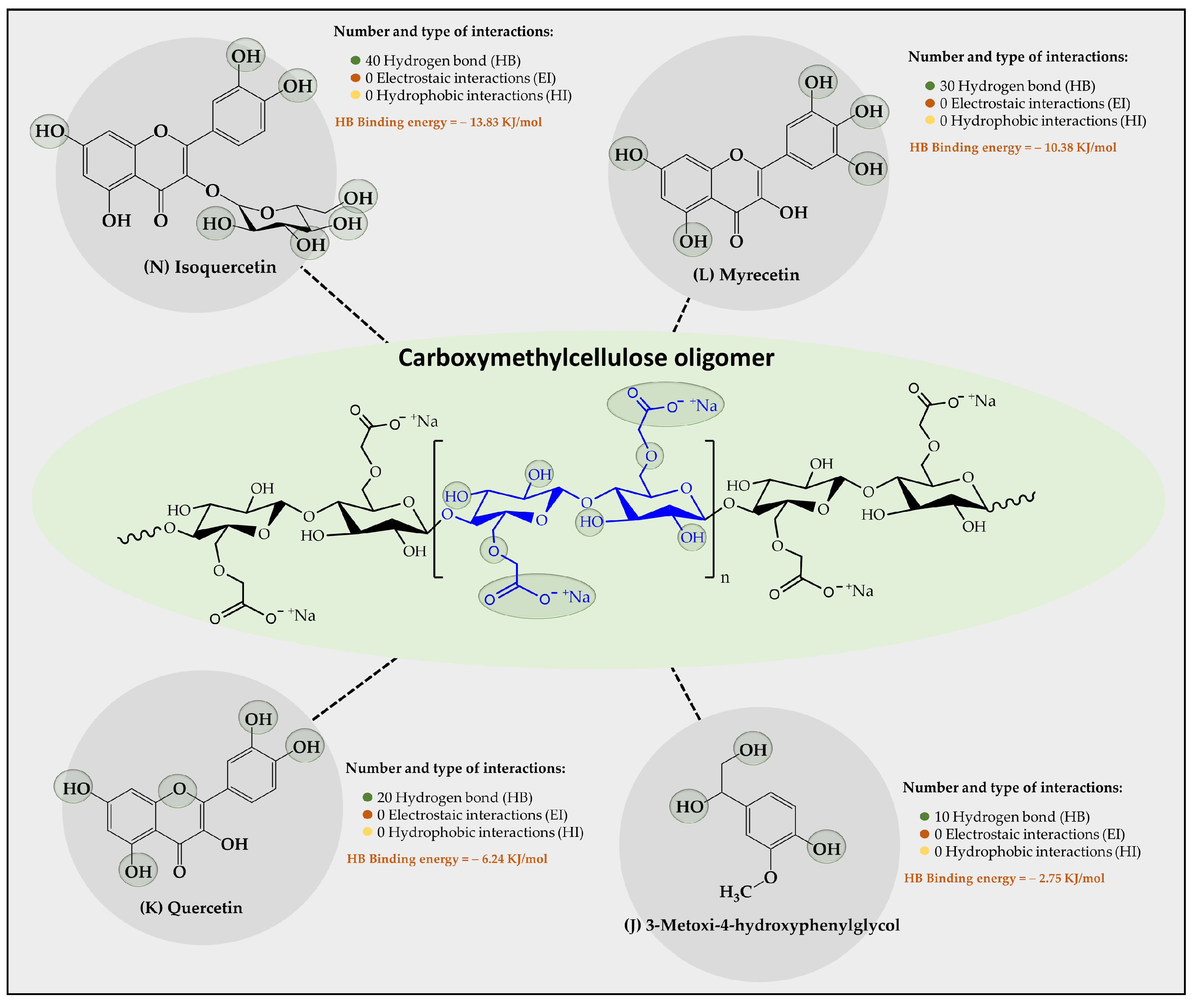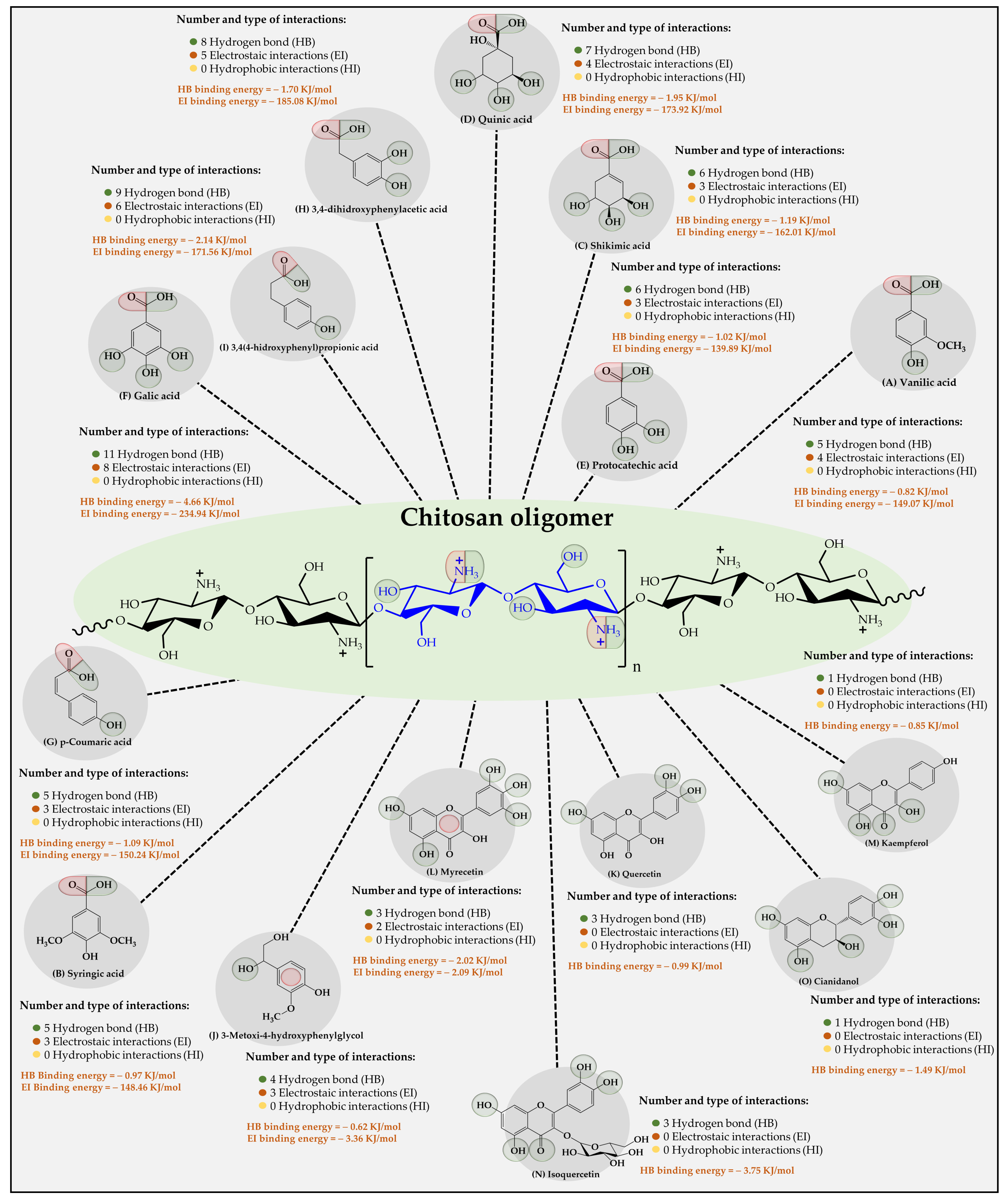Biopolymers as a Potential Alternative for the Retention of Pollutants from Vinasse: An In Silico Approach
Abstract
:1. Introduction
2. Materials and Methods
2.1. 3D Modeling of Sorbents
2.2. Construction of the Sorbent–Sorbate Assembly Model
2.3. Molecular Dynamics Simulation
3. Results and Discussions
4. Conclusions
Author Contributions
Funding
Institutional Review Board Statement
Data Availability Statement
Acknowledgments
Conflicts of Interest
References
- Nadaleti, W.C.; Lourenço, V.A.; Filho, P.B.; Dos Santos, G.B.; Przybyla, G. National Potential Production of Methane and Electrical Energy from Sugarcane Vinasse in Brazil: A Thermo-Economic Analysis. J. Environ. Chem. Eng. 2020, 8, 103422. [Google Scholar] [CrossRef]
- Freitas, P.V.; Da Silva, D.R.; Beluomini, M.A.; Da Silva, J.L.; Stradiotto, N.R. Determination of Phenolic Acids in Sugarcane Vinasse by HPLC with Pulse Amperometry. J. Anal. Methods Chem. 2018, 2018, 4869487. [Google Scholar] [CrossRef] [PubMed]
- Muñoz-Palazon, B.; Rodriguez-Sanchez, A.; Hurtado-Martinez, M.; de Castro, I.M.; Juarez-Jimenez, B.; Gonzalez-Martinez, A.; Gonzalez-Lopez, J. Performance and Microbial Community Structure of an Aerobic Granular Sludge System at Different Phenolic Acid Concentrations. J. Hazard. Mater. 2019, 376, 58–67. [Google Scholar] [CrossRef] [PubMed]
- Moreira, V.R.; Carpanez, T.G.; dos Santos, F.S.; Santos, L.S.; dos Santos Fernandes, D.; França-Neta, L.S.; Lange, L.C.; Amaral, M.C.S. Circular Economy in Biorefineries: Scale-up of Anaerobic/Aerobic Membrane Bioreactors for Vinasse Recycling. J. Clean. Prod. 2022, 377, 134448. [Google Scholar] [CrossRef]
- Montiel-Rosales, A.; Montalvo-Romero, N.; García-Santamaría, L.E.; Sandoval-Herazo, L.C.; Bautista-Santos, H.; Fernández-Lambert, G. Post-Industrial Use of Sugarcane Ethanol Vinasse: A Systematic Review. Sustainability 2022, 14, 11635. [Google Scholar] [CrossRef]
- Russo, T.; Fucile, P.; Giacometti, R.; Sannino, F. Sustainable Removal of Contaminants by Biopolymers: A Novel Approach for Wastewater Treatment. Current State and Future Perspectives. Processes 2021, 9, 719. [Google Scholar] [CrossRef]
- Hubbe, M.A.; Beck, K.R.; O’Neal, W.G.; Sharma, Y.C. Cellulosic Substrates for Removal of Pollutants from Aqueous Systems: A Review. 2. Dyes. BioResources 2012, 7, 2592–2687. [Google Scholar] [CrossRef]
- Martínez-Ruiz, Y.; Manotas-Duque, D.F.; Osorio-Gómez, J.C.; Ramírez-Malule, H. Evaluation of Energy Potential from Coffee Pulp in a Hydrothermal Power Market through System Dynamics: The Case of Colombia. Sustainability 2022, 14, 5884. [Google Scholar] [CrossRef]
- Cerino-Córdova, F.J.; Dávila-Guzmán, N.E.; García León, A.M.; Salazar-Rabago, J.J.; Soto-Regalado, E. Revalorization of Coffee Waste. In Coffee—Production and Research; Toledo Castanheira, D., Ed.; IntechOpen: London, UK, 2020; ISBN 978-1-83880-884-6. [Google Scholar]
- Din, M.F.M.; Ponraj, M.; Low, W.-P.; Fulazzaky, M.A.; Iwao, K.; Songip, A.R.; Chelliapan, S.; Ismail, Z.; Jamal, M.H. Removal Rate of Organic Matter Using Natural Cellulose via Adsorption Isotherm and Kinetic Studies. Water Environ. Res. 2016, 88, 118–130. [Google Scholar] [CrossRef]
- Başaran Kankılıç, G.; Metin, A.Ü. Phragmites Australis as a New Cellulose Source: Extraction, Characterization and Adsorption of Methylene Blue. J. Mol. Liq. 2020, 312, 113313. [Google Scholar] [CrossRef]
- Lapina, V.A.; Akhremkova, G.S. Correlations between the Adsorption and Structural Properties of SV-1 Phytoadsorbent and Its Main Components. Russ. J. Phys. Chem. A 2006, 80, 1164–1166. [Google Scholar] [CrossRef]
- Ali, Z.M.; Mughal, M.A.; Laghari, A.J.; Ansari, A.K.; Saleem, H. Polymeric Cellulose Derivative: Carboxymethyl-Cellulose as Useful Organic Flocculant against Industrial Waste Waters. Int. J. Adv. Res. Technol. 2013, 2, 14–18. [Google Scholar]
- Laverde-Rojas, V.; Liscano, Y.; Rivera-Sánchez, S.P.; Ocampo-Ibáñez, I.D.; Betancourt, Y.; Alhajj, M.J.; Yarce, C.J.; Salamanca, C.H.; Oñate-Garzón, J. Antimicrobial Contribution of Chitosan Surface-Modified Nanoliposomes Combined with Colistin against Sensitive and Colistin-Resistant Clinical Pseudomonas Aeruginosa. Pharmaceutics 2020, 13, 41. [Google Scholar] [CrossRef]
- Bakshi, P.S.; Selvakumar, D.; Kadirvelu, K.; Kumar, N.S. Chitosan as an Environment Friendly Biomaterial—A Review on Recent Modifications and Applications. Int. J. Biol. Macromol. 2020, 150, 1072–1083. [Google Scholar] [CrossRef]
- González-Delgado, Á.D.; Moreno-Sader, K.A.; Martínez-Consuegra, J.D. Biorrefinación Sostenible Del Camarón: Desarrollos Desde La Ingeniería de Procesos Asistida Por Computador, 1st ed.; Corporación Universitaria Minuto de Dios Uniminuto: Bogota, Columbia, 2022; ISBN 978-958-763-558-4. [Google Scholar]
- Sánchez Orozco, M.D.; Angarita Peñaranda, M.R.; Ortiz Ortega, D.A.; Rosas, L.A. Harina de Subproductos de Camarón Como Oportunidad de Inclusión en Dietas para Alimentación Animal. RAA 2018, 5. [Google Scholar] [CrossRef]
- Wang, J.P.; Chen, Y.Z.; Yuan, S.J.; Sheng, G.P.; Yu, H.Q. Synthesis and Characterization of a Novel Cationic Chitosan-Based Flocculant with a High Water-Solubility for Pulp Mill Wastewater Treatment. Water Res. 2009, 43, 5267–5275. [Google Scholar] [CrossRef]
- Poole, C.F.; Gunatilleka, A.D.; Sethuraman, R. Contributions of Theory to Method Development in Solid-Phase Extraction. J. Chromatogr. A 2000, 885, 17–39. [Google Scholar] [CrossRef]
- Simpson, N.J.K. (Ed.) Solid-Phase Extraction: Principles, Techniques, and Applications; Marcel Dekker: New York, NY, USA, 2000; ISBN 978-0-8247-0021-8. [Google Scholar]
- Runge, M.B.; Bowden, N.B. Synthesis of High Molecular Weight Comb Block Copolymers and Their Assembly into Ordered Morphologies in the Solid State. J. Am. Chem. Soc. 2007, 129, 10551–10560. [Google Scholar] [CrossRef] [PubMed]
- De Alvarenga, G.; Hryniewicz, B.M.; Jasper, I.; Silva, R.J.; Klobukoski, V.; Costa, F.S.; Cervantes, T.N.M.; Amaral, C.D.B.; Schneider, J.T.; Bach-Toledo, L.; et al. Recent Trends of Micro and Nanostructured Conducting Polymers in Health and Environmental Applications. J. Electroanal. Chem. 2020, 879, 114754. [Google Scholar] [CrossRef]
- Ali, I.; Gupta, V.K. Advances in Water Treatment by Adsorption Technology. Nat. Protoc. 2006, 1, 2661–2667. [Google Scholar] [CrossRef] [PubMed]
- Reyes, I.; Palacio, M.M.; Yarce, C.J.; Oñate-Garzón, J.; Salamanca, C.H. Relationship between the Ionization Degree and the Inter-Polymeric Aggregation of the Poly(Maleic Acid-Alt-Octadecene) Salts Regarding Time. Polymers 2020, 12, 1036. [Google Scholar] [CrossRef] [PubMed]
- Subash, A.; Naebe, M.; Wang, X.; Kandasubramanian, B. Biopolymer—A Sustainable and Efficacious Material System for Effluent Removal. J. Hazard. Mater. 2023, 443, 130168. [Google Scholar] [CrossRef] [PubMed]
- Nairat, N.; Hamed, O.; Berisha, A.; Jodeh, S.; Algarra, M.; Azzaoui, K.; Dagdag, O.; Samhan, S. Cellulose Polymers with β-Amino Ester Pendant Group: Design, Synthesis, Molecular Docking and Application in Adsorption of Toxic Metals from Wastewater. BMC Chem. 2022, 16, 43. [Google Scholar] [CrossRef] [PubMed]
- Khalaf, B.; Hamed, O.; Jodeh, S.; Bol, R.; Hanbali, G.; Safi, Z.; Dagdag, O.; Berisha, A.; Samhan, S. Cellulose-Based Hectocycle Nanopolymers: Synthesis, Molecular Docking and Adsorption of Difenoconazole from Aqueous Medium. Int. J. Mol. Sci. 2021, 22, 6090. [Google Scholar] [CrossRef]
- Park, S.-J.; Kern, N.; Brown, T.; Lee, J.; Im, W. CHARMM-GUI PDB Manipulator: Various PDB Structural Modifications for Biomolecular Modeling and Simulation. J. Mol. Biol. 2023, 435, 167995. [Google Scholar] [CrossRef] [PubMed]
- Jo, S.; Kim, T.; Iyer, V.G.; Im, W. CHARMM-GUI: A Web-Based Graphical User Interface for CHARMM. J. Comput. Chem. 2008, 29, 1859–1865. [Google Scholar] [CrossRef]
- Abraham, M.J.; Murtola, T.; Schulz, R.; Páll, S.; Smith, J.C.; Hess, B.; Lindahl, E. GROMACS: High Performance Molecular Simulations through Multi-Level Parallelism from Laptops to Supercomputers. SoftwareX 2015, 1–2, 19–25. [Google Scholar] [CrossRef]
- Grubmüller, H.; Heller, H.; Windemuth, A.; Schulten, K. Generalized Verlet Algorithm for Efficient Molecular Dynamics Simulations with Long-Range Interactions. Mol. Simul. 1991, 6, 121–142. [Google Scholar] [CrossRef]
- Harvey, M.J.; De Fabritiis, G. An Implementation of the Smooth Particle Mesh Ewald Method on GPU Hardware. J. Chem. Theory Comput. 2009, 5, 2371–2377. [Google Scholar] [CrossRef]
- Van Der Spoel, D.; Lindahl, E.; Hess, B.; Groenhof, G.; Mark, A.E.; Berendsen, H.J.C. GROMACS: Fast, Flexible, and Free. J. Comput. Chem. 2005, 26, 1701–1718. [Google Scholar] [CrossRef]
- Nielsen, S.O. Nested Sampling in the Canonical Ensemble: Direct Calculation of the Partition Function from NVT Trajectories. J. Chem. Phys. 2013, 139, 124104. [Google Scholar] [CrossRef]
- Bernetti, M.; Bussi, G. Pressure Control Using Stochastic Cell Rescaling. J. Chem. Phys. 2020, 153, 114107. [Google Scholar] [CrossRef]
- Sharma, S. (Ed.) Molecular Dynamics Simulation of Nanocomposites Using BIOVIA Materials Studio, Lammps and Gromacs; Micro and Nano Technologies Series; Elsevier: Amsterdam, The Netherlands; Cambridge, MA, USA, 2019; ISBN 978-0-12-816954-4. [Google Scholar]
- Kumari, R.; Kumar, R. Open Source Drug Discovery Consortium; Lynn, A. G_mmpbsa —A GROMACS Tool for High-Throughput MM-PBSA Calculations. J. Chem. Inf. Model. 2014, 54, 1951–1962. [Google Scholar] [CrossRef]
- Baker, N.A.; Sept, D.; Joseph, S.; Holst, M.J.; McCammon, J.A. Electrostatics of Nanosystems: Application to Microtubules and the Ribosome. Proc. Natl. Acad. Sci. USA 2001, 98, 10037–10041. [Google Scholar] [CrossRef] [PubMed]
- Guo, Z.; Lue, B.-M.; Thomasen, K.; Meyer, A.S.; Xu, X. Predictions of Flavonoid Solubility in Ionic Liquids by COSMO-RS: Experimental Verification, Structural Elucidation, and Solvation Characterization. Green Chem. 2007, 9, 1362. [Google Scholar] [CrossRef]
- Alara, O.R.; Abdurahman, N.H.; Ukaegbu, C.I. Extraction of Phenolic Compounds: A Review. Curr. Res. Food Sci. 2021, 4, 200–214. [Google Scholar] [CrossRef] [PubMed]
- Liu, Y.; Ying, D.; Sanguansri, L.; Cai, Y.; Le, X. Adsorption of Catechin onto Cellulose and Its Mechanism Study: Kinetic Models, Characterization and Molecular Simulation. Food Res. Int. 2018, 112, 225–232. [Google Scholar] [CrossRef] [PubMed]
- Behra, J.S.; Mattsson, J.; Cayre, O.J.; Robles, E.S.J.; Tang, H.; Hunter, T.N. Characterization of Sodium Carboxymethyl Cellulose Aqueous Solutions to Support Complex Product Formulation: A Rheology and Light Scattering Study. ACS Appl. Polym. Mater. 2019, 1, 344–358. [Google Scholar] [CrossRef]
- Capanema, N.S.V.; Mansur, A.A.P.; Mansur, H.S.; De Jesus, A.C.; Carvalho, S.M.; Chagas, P.; De Oliveira, L.C. Eco-Friendly and Biocompatible Cross-Linked Carboxymethylcellulose Hydrogels as Adsorbents for the Removal of Organic Dye Pollutants for Environmental Applications. Environ. Technol. 2018, 39, 2856–2872. [Google Scholar] [CrossRef]
- Liudvinaviciute, D.; Almonaityte, K.; Rutkaite, R.; Bendoraitiene, J.; Klimaviciute, R. Adsorption of Rosmarinic Acid from Aqueous Solution on Chitosan Powder. Int. J. Biol. Macromol. 2018, 118, 1013–1020. [Google Scholar] [CrossRef]
- Flores-Chaparro, C.E.; Rodriguez-Hernandez, M.C.; Chazaro-Ruiz, L.F.; Alfaro-De La Torre, M.C.; Huerta-Diaz, M.A.; Rangel-Mendez, J.R. Chitosan-Macroalgae Biocomposites as Potential Adsorbents of Water-Soluble Hydrocarbons: Organic Matter and Ionic Strength Effects. J. Clean. Prod. 2018, 197, 633–642. [Google Scholar] [CrossRef]
- Kolář, M.; Kubař, T.; Hobza, P. On the Role of London Dispersion Forces in Biomolecular Structure Determination. J. Phys. Chem. B 2011, 115, 8038–8046. [Google Scholar] [CrossRef] [PubMed]
- Meyer, E.; Rosenberg, K.J.; Israelachvili, J. Recent progress in understanding hydrophobic interactions. Proc. Natl. Acad. Sci. USA 2006, 103, 15739–15746. [Google Scholar] [CrossRef] [PubMed]






Disclaimer/Publisher’s Note: The statements, opinions and data contained in all publications are solely those of the individual author(s) and contributor(s) and not of MDPI and/or the editor(s). MDPI and/or the editor(s) disclaim responsibility for any injury to people or property resulting from any ideas, methods, instructions or products referred to in the content. |
© 2023 by the authors. Licensee MDPI, Basel, Switzerland. This article is an open access article distributed under the terms and conditions of the Creative Commons Attribution (CC BY) license (https://creativecommons.org/licenses/by/4.0/).
Share and Cite
Aristizabal, Y.; Ciro, Y.; Liscano, Y.; Salamanca, C.H.; Oñate-Garzón, J. Biopolymers as a Potential Alternative for the Retention of Pollutants from Vinasse: An In Silico Approach. Polymers 2024, 16, 11. https://doi.org/10.3390/polym16010011
Aristizabal Y, Ciro Y, Liscano Y, Salamanca CH, Oñate-Garzón J. Biopolymers as a Potential Alternative for the Retention of Pollutants from Vinasse: An In Silico Approach. Polymers. 2024; 16(1):11. https://doi.org/10.3390/polym16010011
Chicago/Turabian StyleAristizabal, Yesid, Yhors Ciro, Yamil Liscano, Constain H. Salamanca, and Jose Oñate-Garzón. 2024. "Biopolymers as a Potential Alternative for the Retention of Pollutants from Vinasse: An In Silico Approach" Polymers 16, no. 1: 11. https://doi.org/10.3390/polym16010011
APA StyleAristizabal, Y., Ciro, Y., Liscano, Y., Salamanca, C. H., & Oñate-Garzón, J. (2024). Biopolymers as a Potential Alternative for the Retention of Pollutants from Vinasse: An In Silico Approach. Polymers, 16(1), 11. https://doi.org/10.3390/polym16010011









